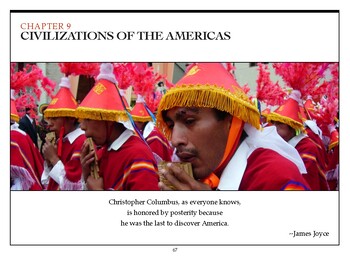WH9 - Civilizations of the Americas - Document Based Question
- PDF
Description
A document-based question (DBQ) is a type of essay question that asks students to analyze primary and secondary sources on a particular historical topic or theme. Students are typically given a packet of documents and asked to use these sources to answer a specific question or prompt. DBQs are commonly used in AP and college-level history courses, and they require students to demonstrate their ability to analyze and interpret historical sources, as well as to develop and support an argument based on evidence.
This resource can be tailored to meet your needs in the classroom.
You can use it in a wide variety of ways including but not limited to:
- Collaborative Reading: Have students read the DBQ together in small groups, guiding each other through any difficult vocabulary or passages.
- Document Analysis: Students can analyze individual documents and summarize their main ideas, and then they can compare their findings with others in the class.
- Jigsaws: Divide the documents in the DBQ amongst different groups of students, have them read and summarize them, and then present their findings to the class.
- Timeline Construction: Using the chronological documents in the DBQ, students can create a timeline of key events or developments.
- Historical Debates: Students can use the evidence presented in a DBQ to construct arguments for or against a given point of view.
- Essay Writing: After analyzing the documents and drawing conclusions, students can write an essay in response to a prompt related to the DBQ topic.
- Quiz Bowl: Divide the class into two teams and use DBQ questions and documents to create a trivia-style game.
- Creative Projects: Encourage students to create posters or other visual projects using the documents provided in the DBQ.
Historical Context Between 300 and 1500, three advanced civilizations developed in Central and South America. The Mayas flourished from 250 to 900. Mayan ruins remain even today in Central America. The Aztecs conquered most of Mexico. They built a highly developed civilization in the 1400s. At the same time, the Incas were building an empire in Peru.
Directions: The following question is based on the accompanying documents in Part A. As you analyze the documents, take into account both the source of each document and the author’s point of view. Be sure to do each of the following steps:
- Carefully read the document-based question. Consider what you already know about this topic. How would you answer the question if you had no documents to examine?
- Read each document carefully, underlining key phrases and words that address the document-based question. You may also wish to use the margin to make brief notes. Answer the questions that follow each document before moving on to the next document.
- Based on your own knowledge and on the information found in the documents, formulate a thesis that directly answers the document-based question.
- Organize supportive and relevant information into a brief outline.
- Write a well-organized essay proving your thesis. You should present your essay logically. Include information both from the documents and from your own knowledge beyond the documents.





